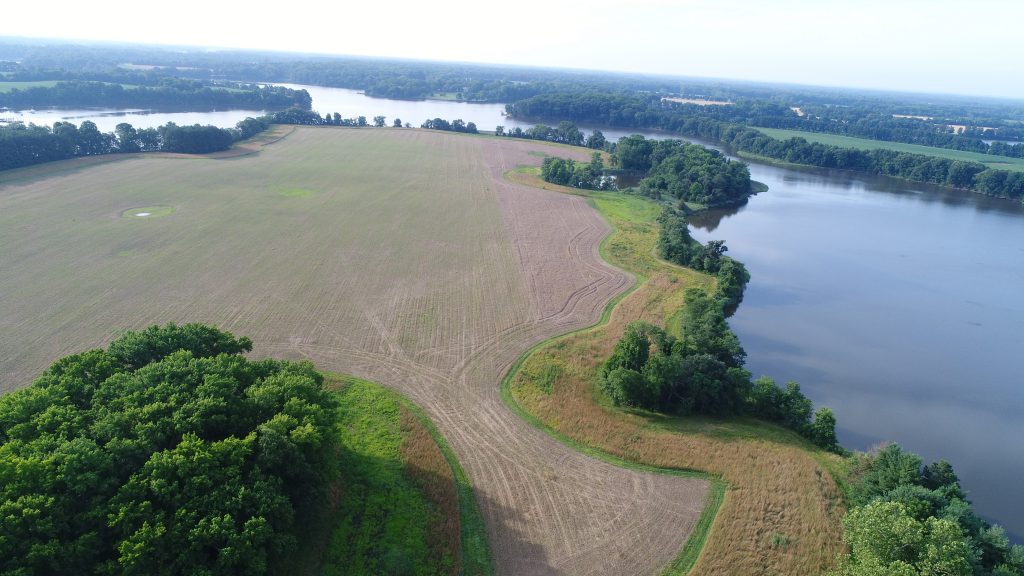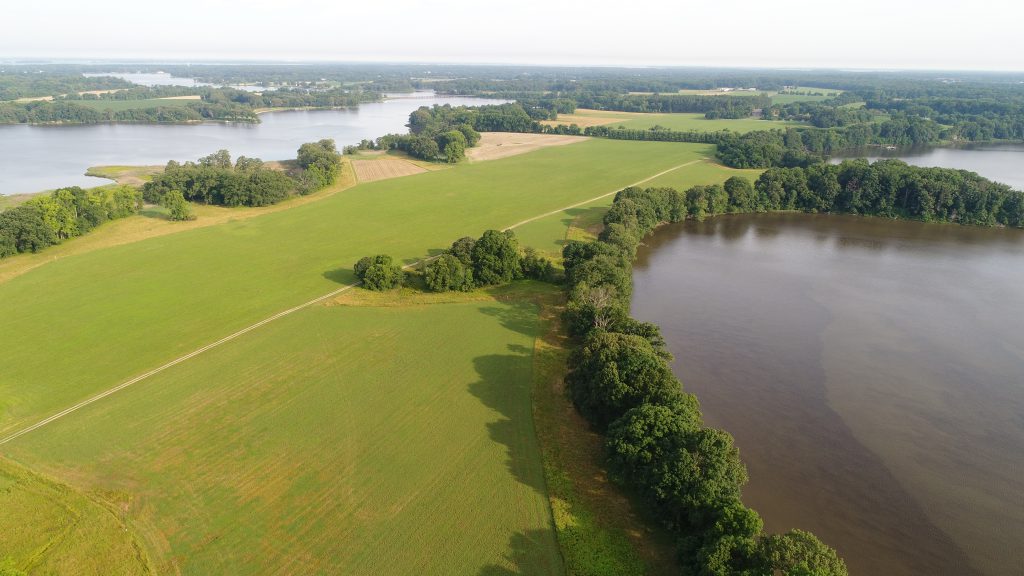
The Wye River and its tributaries surround the conservation easement lands by Joe Streett
The preservation of natural areas and agricultural land often go hand in hand, or in some cases, hoof in hoof. This year, a treasured agricultural resource in Queen Anne’s County has been protected forever through the work of the Maryland Environmental Trust (MET).
The Aspen Institute, owner of property on Maryland’s Eastern Shore that houses the Wye Angus Program of the University of Maryland, granted MET and the Eastern Shore Land Conservancy Inc. a conservation easement on more than 586 acres of active farmland, which is the long-time home of renowned Black Angus cattle.
The easement protects the farmland from ever being used for residential purposes. The Aspen Institute then conveyed ownership of the protected land to the University of Maryland. MET and Eastern Shore Land Conservancy staff worked closely with the Wye Angus Program and the Aspen Institute on the easement agreement to ensure the educational, research, and agricultural uses of the land will continue benefitting all Marylanders.
In addition, the land provides beautiful scenic views of forested waterfront and open pasture along Carmichael Road, which is part of the Chesapeake Country Scenic Byway. The protected land also offers more than three miles of scenic frontage along the Wye Narrows and East Wye River waterways, and is visible from the Wye Island Natural Resource Management Area.

Point Field, part of an agricultural conservation area along the Wye River in Eastern Maryland
The Aspen Institute donated 330 acres along with existing buildings to the University of Maryland for continued use by the Wye Angus program, which is maintained and operated by the College of Agriculture and Natural Resources (AGNR) at the Wye Research and Education Center in Queenstown. In addition, the university purchased another 233 acres for a total land acquisition of 563 acres.
The Wye Angus program is a research and education program built around a carefully bred herd of cattle, gifted to UMD in 1979 by the late businessman Arthur A. Houghton Jr. and his wife Nina Houghton.
Since establishing the Wye Angus program more than 40 years ago, the university has leased the land to support the herd from the Aspen Institute, which originally received the land as a gift from the Houghtons. The recent donation and sale means UMD now owns the land needed to maintain the herd, and can ensure its future. As part of the agreement, the land will remain in a conservation easement held by the Maryland Environmental Trust and the Eastern Shore Land Conservancy, which preserves the agricultural and environmental attributes of the property in perpetuity.
“We have appreciated the partnership with the Aspen Institute as the owners and stewards of this land for 40 years, and their generous gift, along with the purchase of additional acres allows us to continue and expand our research excellence in genetics and sustainable food production,” said UMD President Darryll J. Pines. “We have a responsibility to address grand challenges and serve the public good for all of humanity, and we look forward to using this as an opportunity to find new ways to improve food security for the world’s growing population.”
The Wye Angus herd is highly desired for the hearty, low-maintenance traits Houghton bred into the cattle using bulls imported from the British Isles, but the Wye Angus’s greatest value is that it is a closed herd, meaning no new bloodlines have been introduced to the gene pool since 1958. The genetic similarity of individuals reduces variability and enables research studies that would be more difficult to interpret in a genetically diverse herd. The herd also serves as a training tool for undergraduate and graduate students pursuing degrees in beef science and production.
“This acquisition is a strong signal of the commitment of AGNR and UMD,” said AGNR Dean Craig Beyrouty, “not only to agriculture on Maryland’s Eastern Shore, but to the unique resources of the cattle herd and natural surroundings that allow us to continue our role as leaders in environmental stewardship and solving food security issues locally and globally.”
The gift of 330 acres is valued at nearly $2.8 million and includes a pole barn and two buildings. UMD is purchasing the additional 233 acres for $936,632. The buildings will provide new office and meeting space to enable WyeRec to better serve College Park campus programs. One of the first new offerings will be a class on farm equipment safety and maintenance in the Spring of 2023.
“Since 1979, the Wye River campus has played an important role in the Aspen Institute’s history,” said Dan Porterfield, president and CEO of the Aspen Institute. “This beautiful and protected site has hosted countless seminars and convenings, including some of international significance. We are delighted that a significant portion of the land will now fall under the stewardship of the University of Maryland. They already have a long association with the property, and I am confident that they will be excellent custodians of this remarkable part of Maryland’s Eastern Shore.”
Houghton’s stepson, Jeff Horstman, who lives nearby, said the family is very pleased that the spirit and intent of the original gift will be maintained in this recent transfer. “The cattle are very important to us as a reminder of my stepfather and the people who were here before us,” he said. “Aspen Institute has been a great steward of the land, and the University of Maryland cowboys who manage the herd are like family to us, so it’s important to know that the cattle will remain here and an environmentally sensitive peninsula will remain protected along the Chesapeake Bay.”
dnr.maryland.gov/met
Kimbra Cutlip is Assistant Director of Communications with the University of Maryland College of Agriculture and Natural Resources. Michelle Grafton is Land Trust Assistance Manager with the Maryland Environmental Trust. Portions of this article were originally published by the University of Maryland College of Agriculture and Natural Resources. Article appears in Vol. 26, No. 2 of the Maryland Natural Resource magazine.
